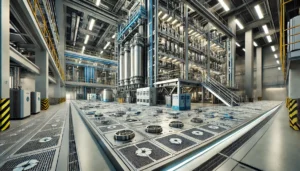Raised Flooring in Educational Institutions: Advantages and Challenges
Discover how raised flooring transforms educational spaces. This versatile solution optimizes technology integration, enhances safety, and streamlines maintenance in schools, colleges, and universities. Explore the benefits and challenges to make an informed decision for your institution. Raised Flooring in Educational Institutions Advantages and Challenges.
Educational institutions are rapidly evolving to meet the demands of modern teaching and learning. As technology becomes an integral part of the classroom, the infrastructure supporting it must adapt. Raised flooring systems are gaining popularity in educational settings, offering numerous advantages while also presenting certain challenges.
What is Raised Flooring?
Raised flooring is a modular system of floor panels elevated above the subfloor, creating an accessible void. This void can accommodate cabling, HVAC systems, and other utilities, making it an ideal solution for educational institutions aiming for future-ready infrastructure.
Advantages of Raised Flooring in Educational Institutions
- Efficient Cable Management: Modern classrooms and lecture halls require extensive wiring for technology integration. Raised flooring simplifies cable management, ensuring a clutter-free and safe environment. Raised Flooring in Educational Institutions Advantages and Challenges
- Flexibility and Scalability: As technology and space requirements change, raised flooring allows easy access to infrastructure, enabling quick adjustments.
- Enhanced Aesthetics: By hiding unsightly cables and pipes, raised flooring creates a clean and professional appearance.
- Improved Airflow and Climate Control: Incorporating HVAC systems within the raised flooring enhances air distribution, contributing to a comfortable learning environment.
- Cost Savings on Maintenance: Easy access to utilities reduces downtime and maintenance costs.
- Safety Benefits: Concealed wiring minimizes tripping hazards, ensuring a safer environment for students and staff.
- Sustainability: Many raised flooring systems use eco-friendly materials and contribute to sustainable building practices.
Challenges of Raised Flooring in Educational Institutions
- Initial Costs: The upfront investment for raised flooring can be significant compared to traditional flooring.
- Structural Considerations: Older buildings may require modifications to support the additional weight.
- Installation Complexity: Professional expertise is essential for proper installation. Raised Flooring in Educational Institutions Advantages and Challenges
- Acoustic Concerns: Poor installation or material choice may lead to sound transmission issues.
- Cleaning Requirements: Regular cleaning beneath the flooring may be necessary to prevent dust accumulation.
By carefully weighing these pros and cons, educational institutions can decide if raised flooring aligns with their goals and budgets.
Specifications Table
| Feature | Description |
|---|---|
| Material | Steel, aluminum, or composite panels |
| Load Capacity | Up to 1000 lbs. per panel |
| Height Range | Adjustable from 3 inches to 48 inches |
| Panel Dimensions | Standard 24” x 24” size |
| Fire Resistance | Meets ASTM E84 standards |
| Cable Management | Integrated trays for organized wiring |
| Surface Finish | Anti-static laminate, carpet, or vinyl |
| Weight per Panel | Approximately 10-20 lbs. per panel |
| Installation Method | Screw or pedestal systems |
| Ventilation | Perforated panels available |
| Warranty | 10-15 years |
| Maintenance Requirements | Minimal; routine inspections |
| Sustainability | Recyclable materials |
| Acoustic Performance | Sound-absorbing underlays available |
| Customizable Options | Height, finish, and panel type |
FAQs
1. What is raised flooring in educational institutions? Raised flooring is a modular system designed to elevate the floor surface, creating a space for utilities like cables, HVAC, and plumbing. Raised Flooring in Educational Institutions Advantages and Challenges
2. Why is raised flooring beneficial for schools and universities? It offers efficient cable management, improved safety, enhanced aesthetics, and easy maintenance, making it ideal for modern educational environments.
3. Are there any challenges associated with raised flooring? Yes, challenges include higher initial costs, structural requirements, and potential acoustic issues.
4. Can raised flooring be installed in older buildings? Yes, but structural assessments are necessary to ensure the building can support the added weight.
5. How long does raised flooring last? With proper maintenance, raised flooring can last 15-20 years or more.
Why Choose Raised Flooring in Educational Institutions: Advantages and Challenges?
Choosing raised flooring for educational institutions is a strategic investment in functionality, safety, and future adaptability. It supports modern teaching methods by seamlessly integrating technology while maintaining a clean and organized environment. Although initial costs may be higher, the long-term benefits of improved maintenance, scalability, and aesthetics far outweigh the drawbacks. Raised Flooring in Educational Institutions Advantages and Challenges
Pros and Cons Table
| Pros | Cons |
| Efficient cable and utility management | Higher upfront costs |
| Enhanced safety and aesthetics | Structural modifications may be needed |
| Flexibility and scalability | Requires professional installation |
| Supports sustainable building practices | Potential acoustic issues |
| Improves air circulation with HVAC | Regular cleaning may be required |
|
|
|
|



